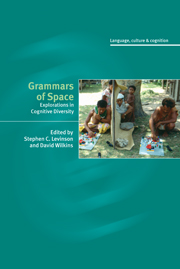Book contents
- Frontmatter
- Contents
- List of figures
- List of tables
- List of contributors
- Preface
- 1 The background to the study of the language of space
- 2 Towards an Arrernte grammar of space
- 3 Sketch of a Jaminjung grammar of space
- 4 Prolegomenon to a Warrwa grammar of space
- 5 The language of space in Yélî Dnye
- 6 Prolegomena to a Kilivila grammar of space
- 7 A sketch of the grammar of space in Tzeltal
- 8 Spatial reference in Yukatek Maya: a survey
- 9 Approaching space in Tiriyó grammar
- 10 Elements of the grammar of space in Ewe
- 11 Spatial language in Tamil
- 12 A grammar of space in Japanese
- 13 Some properties of spatial description in Dutch
- 14 Patterns in the data: towards a semantic typology of spatial description
- Appendices
- References
- Author index
- Language/Language family index
- Subject index
9 - Approaching space in Tiriyó grammar
Published online by Cambridge University Press: 22 September 2009
- Frontmatter
- Contents
- List of figures
- List of tables
- List of contributors
- Preface
- 1 The background to the study of the language of space
- 2 Towards an Arrernte grammar of space
- 3 Sketch of a Jaminjung grammar of space
- 4 Prolegomenon to a Warrwa grammar of space
- 5 The language of space in Yélî Dnye
- 6 Prolegomena to a Kilivila grammar of space
- 7 A sketch of the grammar of space in Tzeltal
- 8 Spatial reference in Yukatek Maya: a survey
- 9 Approaching space in Tiriyó grammar
- 10 Elements of the grammar of space in Ewe
- 11 Spatial language in Tamil
- 12 A grammar of space in Japanese
- 13 Some properties of spatial description in Dutch
- 14 Patterns in the data: towards a semantic typology of spatial description
- Appendices
- References
- Author index
- Language/Language family index
- Subject index
Summary
Introduction: Tiriyó and its speakers
Tiriyó is a language of the Taranoan (Tiriyó) subbranch of the Cariban language family (Kaufman 1994, Gildea 1998, Derbyshire 1999, Meira 1999a). It has approximately 2,000 speakers living in several villages scattered on both sides of the Brazil–Surinam border in northern Amazonia (the dialect described in the present work is typical of the Missão Tiriós area in Brazil). Extensive descriptions of Tiriyó grammar are Meira 1999a (published as 2006) and Carlin 2004; earlier studies, dealing mostly with some aspects of the morphology, include an unpublished manuscript by Claude Leavitt, a missionary, and De Goeje's grammar sketch (1909). More specific aspects of the language are discussed in Carlin 1997, 1998, 1999, 2003, 2006, Meira 1997, 1998, 1999a, 1999b, 2000b, 2000c, 2001, 2003a, 2003b, 2004a, 2004b, and a historical perspective is given in Meira 2000a.
The word tarëno [taɽə:no] (etymologically, ‘someone from here, a local person’) is normally used as an autodenomination, though it can, on occasion, be extended to other Amerindians (but not to Westerners, Mestizos, or Blacks). The word tïrïjo [tɨɽɨ:jo] is used by people from neighbouring groups, and in its westernized versions Tiriyó in Brazil and Trio in Surinam, by non-Amerindians. The Tiriyó recognize this word and use it to refer to themselves when dealing with other people, but they consider it a foreign word.
In all Tiriyó villages, the Tiriyó language is the normal means of everyday communication. Almost all the Tiriyó are monolingual.
- Type
- Chapter
- Information
- Grammars of SpaceExplorations in Cognitive Diversity, pp. 311 - 358Publisher: Cambridge University PressPrint publication year: 2006
- 4
- Cited by

